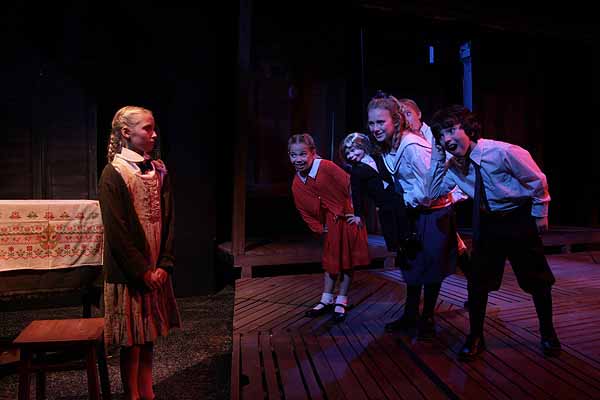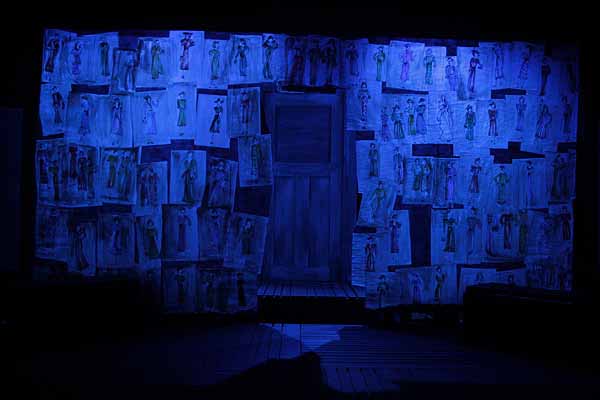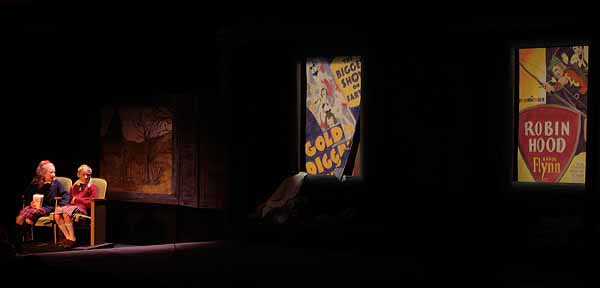

SCENIC
and LIGHTING DESIGN
The Hundred Dresses
adapted by Mary Hall Surface
from the book by Eleanor Estes
Zona Gale Theatre
Portage
Center for the Arts
Portage, WI
September 2008
Costume Design by Barb Church
Directed by Christine Grimm
Artistic Director: Dr. Xan S. Johnson

Act 1, Scene 2: Willie and Jack try to impress Peggy and Cecile.

Act 1, Scene 2: Cecile, Maddie and Peggy play while Wanda watches.

Act 1, Scene 3: Miss Mason leads class. Notice the benches - they were integrated into the deck to facilitate quick changes.


Act 1, Scene 6 (both above): One of Maddie's fantasies, this one a fear laden scenario where she becomes the object of humiliation.

Act 1, Scene 7: Maddie and Jack are told off by Jake, while Wanda holds him back.


Act 2, Scene 1 (both above): Wanda's hundred dressses are revealed.

Act 2, Scene 4: At the movie theatre. Just prior to another fantasy sequence.

Act 2, Scene 6: Wanda makes peace with "Old Man Swenson."

Act 2, Scene 8: The final tableau. Maddie remembers Wanda for the last time.
<
Production Notes:
Set in 1938, this is the story of how Maddie Reeves deals with her guilt after she and her friends make fun of a "little Polish girl," Wanda Petronski. While on the playground, Wanda tells the girls that she has "a hundred dresses." Peggy and Cecile lead the charge to make fun of Wanda, but Maddies does nothing to discourage it, much to her guilt. Additionally, the boys, Jack and Wille, plot against "Old Man Swenson," who also lives in the undesirable neighborhood of Boggins Heights. After Wanda and her family leave town (to escape the ridicule they all face), the children discover that Wanda's "hundred dresses" were drawings she made to enter a design contest at school. Maddie is able to make amends with Mr. Swenson, but her resolution with Wanda is largely in her head.
The largest design challenge is that there are 16 scenes (8 in each of the 2 acts) in numerous locations. Since our stage has no wing or fly space and virtually no upstage space, the bulk of the scenery needs to remain in place or be trundled on and off by the actors through the audience. Since "the porch" is a central image at the start and throughout the play, and since it played such a large role in Depression era research, it became our focal point, (though it really only shows up in the Act 2, Scene 6 photo), as it was not lit well in scenes that were not realistically on the porch. As part of the design, the benches used for the 3 classroom scenes were integrated into the flooring. (See image below.)

While this is all fine and good, the real design element became the small drops (I like the term droplets) that were used in the window frames across the set. (2 frames are upstage center, and 2 are offstage left and right). In all there were 42 droplets, 17 pair in the inner set of window frames (1 pair for each scene, plus the final tableau moment) and 4 pair on the outter set of window frames (to denote the passage of time, they were the same view in the four months of the play, September through December). While in the first act, these drops were discarded discretely behind the set, in act two, they were simply left to accumulate in the corner of the porch (see in particular Act 2, Scene 6 photo). This represented the manner in which Wanda and her family were crumpled up and discarded (ala a piece of used drawing paper).
Additionally, there was a framing unit (a series of dresses, positive and negative), that were accented with lighting during Maddie's frequent fantasy moments. Especially in Act 2, they serve as a reminder of Wanda and how Maddie's guilt is eating away at her.
Finally, since the show is all about the Hundred Dresses: the "Hundred Dresses Drop." Since we have no fly space, the drop was rolled and unrolled under the eaves of the porch roof. While it didn't exactly magically appear and disappear, it was a quick solution. And yes, there really are 100 dresses painted on the drop, thanks to scenic artist (she's actually just a regular ol' artist) Elizabeth Gregory.
Lighting was kept fairly neutral, slightly amber to augment a sepia-toned image of the Depression, then enriched with color during Maddie's fantasies. There was also a use of texture and shadow on Boggin's Heights, the low-class part of town, that heightened the undesirable nature of Wanda and Mr. Swenson's home.
See the PAINTING page for a couple of the droplets I painted.
